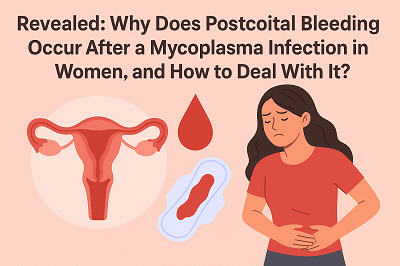Revealed: Why Does Postcoital Bleeding Occur After a Mycoplasma Infection in Women, and How to Deal With It?
Mycoplasma are prokaryotic microorganisms without a cell wall. Among them, genital mycoplasma and ureaplasma urealyticum are most commonly associated with reproductive system infections. The primary transmission route is sexual contact, including vaginal intercourse, oral sex, and anal sex. Although indirect transmission through contaminated towels or clothing can happen, it is relatively rare.

After being infected with mycoplasma, some women may experience a particularly distressing problem—postcoital bleeding. This does not occur out of nowhere; rather, it is the result of a chain of physical changes triggered by the infection. Understanding the underlying causes is crucial for timely management.
I. Direct Mechanisms of Mycoplasma-Induced Bleeding
1. Cervicitis and cervical mucosal congestion/edema
When mycoplasma enter the reproductive tract through sexual contact, they first “settle” in the cervical mucosa. Continuous irritation leads to mucopurulent cervicitis, causing the cervical mucosa to become red, swollen, and fragile. Normal tissue turns sensitive and easily damaged, so even minor friction during intercourse can cause rupture and bleeding. Typically, this bleeding appears immediately after intercourse as a small amount of bright red blood or blood-streaked discharge.
2. Progression to endometritis or pelvic inflammatory disease (PID)
If the infection is not controlled in time, mycoplasma may spread upward, leading to endometritis and, in severe cases, PID. The infected endometrium becomes congested, edematous, and unstable, prone to irregular shedding. This can cause spotting after intercourse and even intermenstrual bleeding. If the infection extends to the fallopian tubes, it may result in salpingitis, causing dull lower abdominal pain or pelvic heaviness, with more serious reproductive system damage.
3. Inflammatory mediator release
Mycoplasma release lipids and lipoproteins that activate the body’s TLR signaling pathway, like flipping a switch that triggers massive inflammatory mediator release. This attracts neutrophils to the site of infection. While neutrophils attempt to kill pathogens, they also release reactive oxygen species that damage surrounding tissue and make local microvessels more prone to rupture and bleeding.
II. Confusing Factors and Differential Diagnosis
Postcoital bleeding caused by mycoplasma infection may easily be confused with other conditions, so careful distinction is necessary to avoid misdiagnosis.
1. Coinfections with other sexually transmitted pathogens
STIs often “cluster together.” Many patients are not only infected with mycoplasma but may also have chlamydia or gonorrhea. These combined infections exacerbate inflammation in the cervix and reproductive tract, making bleeding more pronounced. Therefore, testing should not focus only on mycoplasma but also cover other common STIs.
2. Non-infectious causes
Other conditions may also lead to postcoital bleeding, requiring attention.
- Cervical polyps: Soft and vascular, prone to bleeding upon contact during intercourse.
- Cervical ectropion: Columnar epithelium exposed on the cervix, leaving mucosa fragile and easily damaged.
- Postmenopausal vaginal atrophy: Thinned, less elastic vaginal mucosa tears easily during sex.
- Trauma during intercourse or serious conditions like cervical cancer may also cause postcoital bleeding. Notably, early cervical cancer may present only with postcoital bleeding, making further examination essential for exclusion.
III. Warning Signs and When to Seek Medical Attention
If postcoital bleeding occurs along with these warning signals, immediate medical evaluation is required:
Heavy bleeding: If sanitary pads need to be changed every 2 hours, it indicates significant vascular injury or pathology, requiring urgent care.
Accompanying symptoms: Persistent lower abdominal pain may indicate deep infections like PID; fever suggests systemic inflammatory response; foul-smelling vaginal discharge may point to severe infection or tissue necrosis. All these warrant immediate hospital evaluation.
Recurrent postcoital bleeding: Even if each episode is minor, repeated bleeding may signal unresolved infection or cervical pathology and must be investigated.
IV. Diagnostic and Treatment Pathways
(1) Diagnostic approach
Accurate diagnosis is key to effective treatment.
Laboratory tests: Cervical swabs or first-void morning urine samples can reliably detect mycoplasma, chlamydia, and gonorrhea.
Colposcopy combined with cervical cytology: Allows direct visualization of cervical status and identification of polyps or malignancy.
(2) Treatment methods
Antibiotics remain the mainstay of treatment for mycoplasma infection. If resistance occurs or treatment is ineffective, moxifloxacin may be used. Medication must be taken strictly under a doctor’s guidance, without altering dose or duration.
Additionally, Fuyan Pill can be used. It has functions of clearing heat and detoxifying, activating blood circulation, and strengthening the spleen to drain dampness. It can kill bacteria and viruses within about three months, turning tests for mycoplasma, chlamydia, and gonorrhea negative.
Importantly, sexual partners must be treated simultaneously to avoid cross-infection.
Conclusion
In summary, postcoital bleeding after mycoplasma infection is essentially due to “infection-induced inflammation that makes tissues prone to bleeding.” Regardless of the underlying cause, abnormal bleeding is a warning signal from the body and should never be ignored. Early hospital evaluation to identify the exact cause, followed by targeted treatment, is the only way to resolve the issue and prevent worsening of the condition.
- Revealed: Why Does Postcoital Bleeding Occur After a Mycoplasma Infection in Women, and How to Deal With It?
- Have You Ever Considered? Your Wife's Recurrent Mycoplasma Infections Might Be Linked to You!
- True or False: Can Sexual Activity Continue with Gynecological Mycoplasma Infection as Long as Contraceptive Measures Are Taken?
- Hidden Dangers of Mycoplasma and Chlamydia: The Crucial Role of Pre-Pregnancy Check-Ups
- Does Mycoplasma Always Cause Fallopian Tube Blockage?
Testimonials
- Adenomyosis with Ureaplasma Urealyticum Cured by Fuyan Pill
- Tubal blockage with hydrosalpinx can be cured by TCM shortly
- Fuyan Pill Helps A woman with Adenomyosis Get Pregnant
- A Woman with Hydrosalpinx Is Cured with Fuyan pill
- Pelvic Inflammatory Disease Testimonials
- Irregular Vaginal Bleeding and Endometrial Thickening Cured by Fuyan Pill
- Pruritus Vulvae and Frequent Urination: Mycoplasma Infection Cured after 2 Courses



